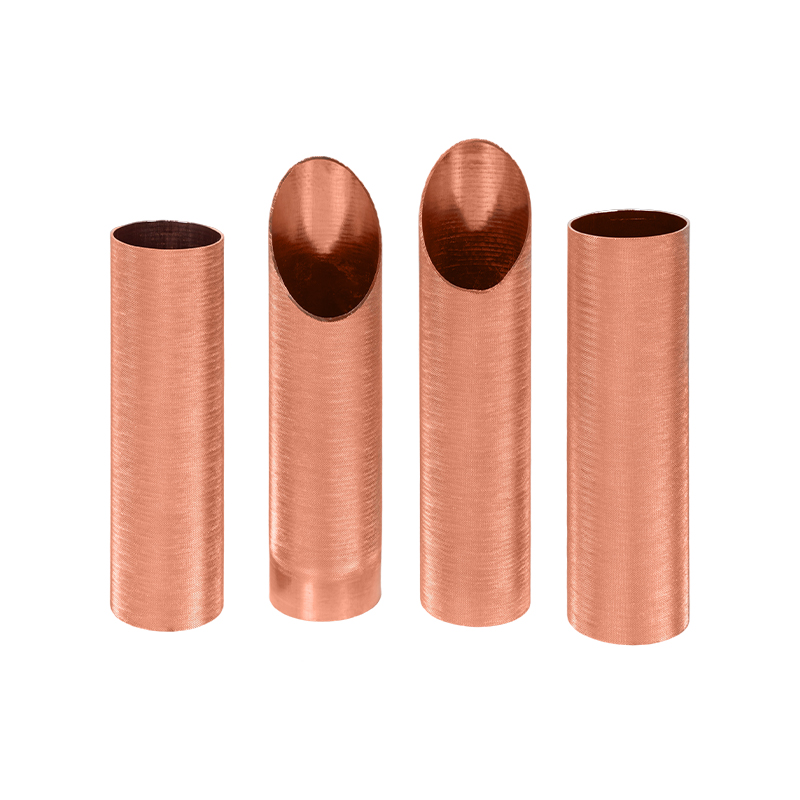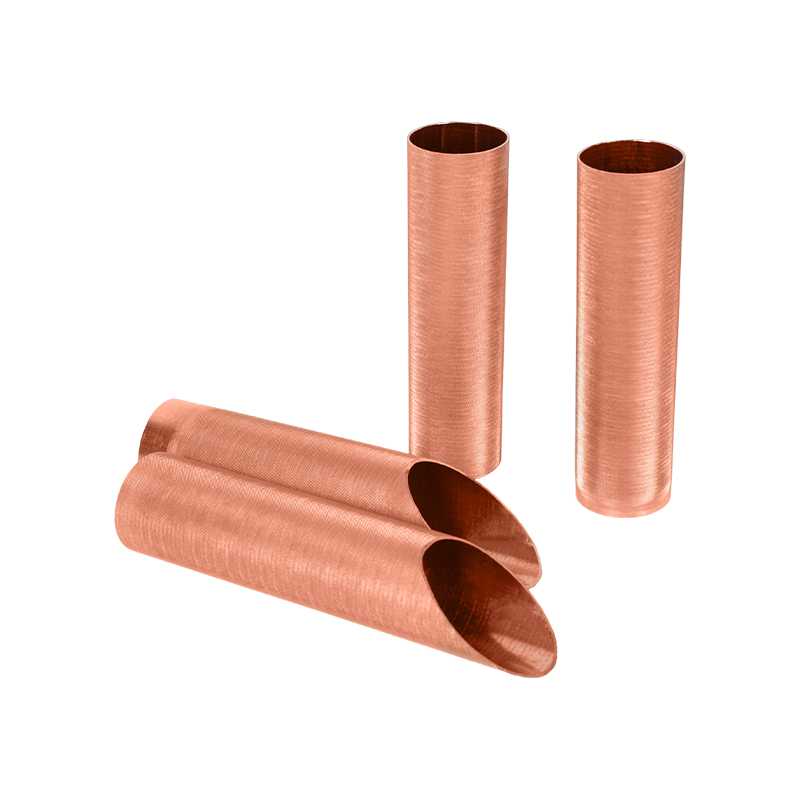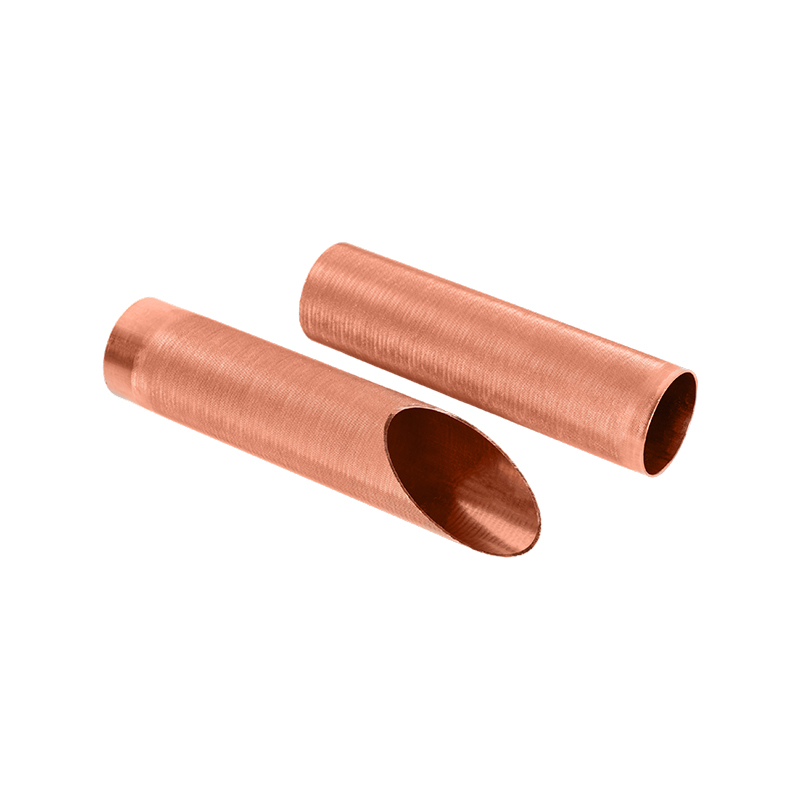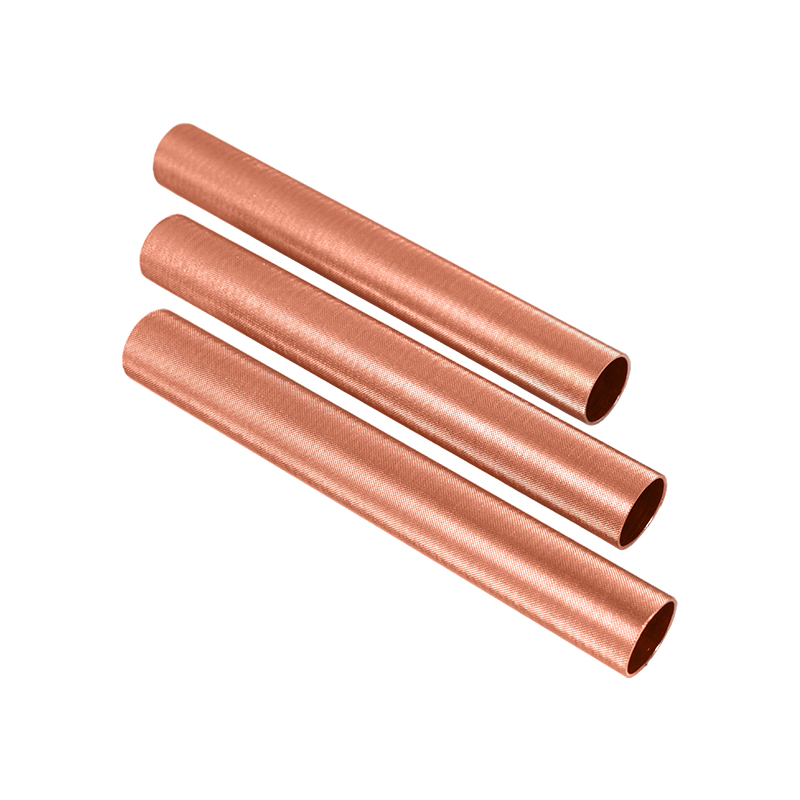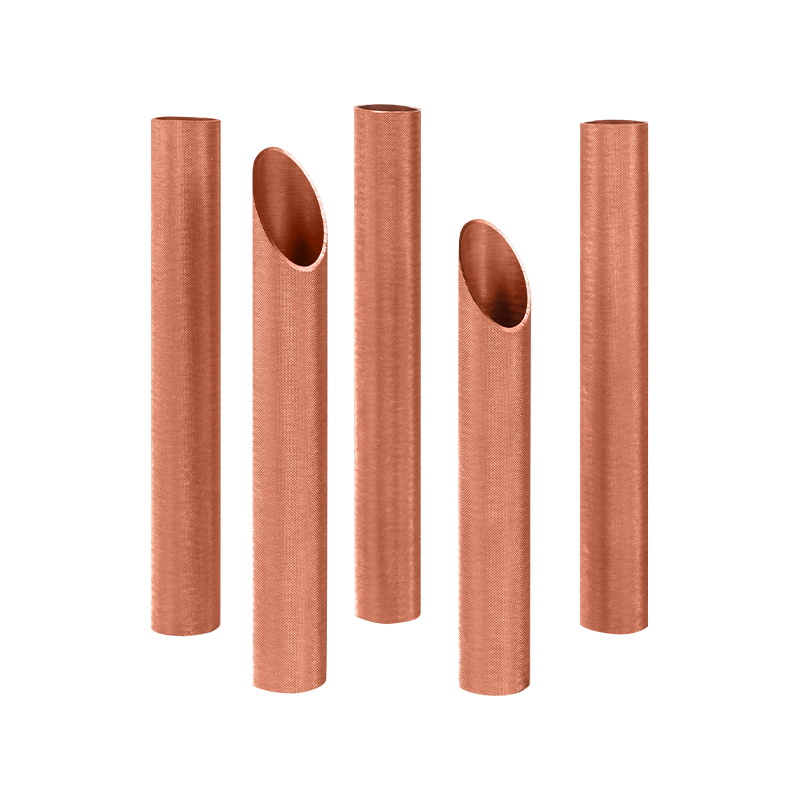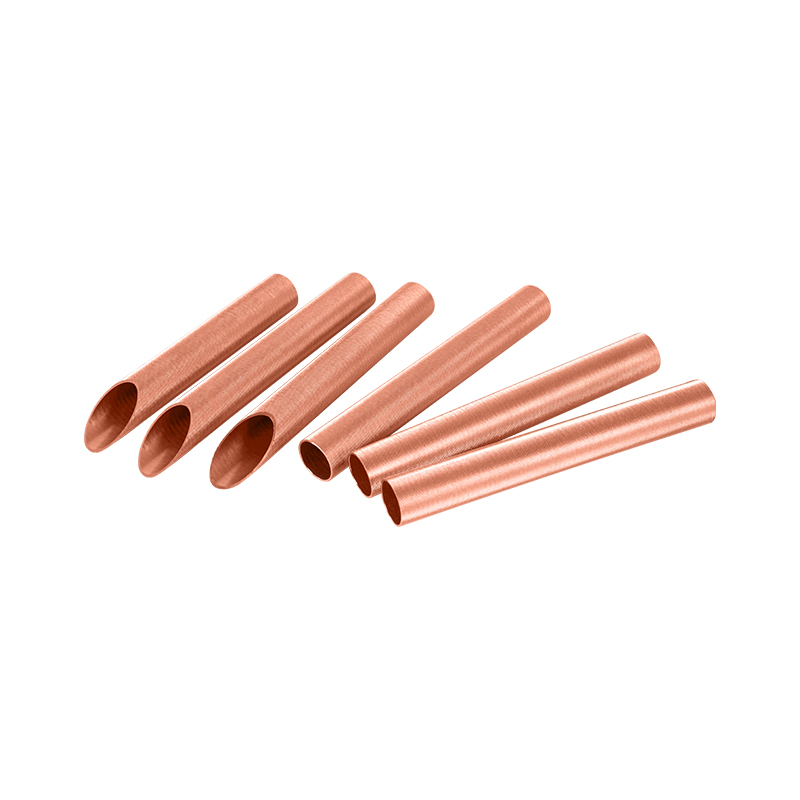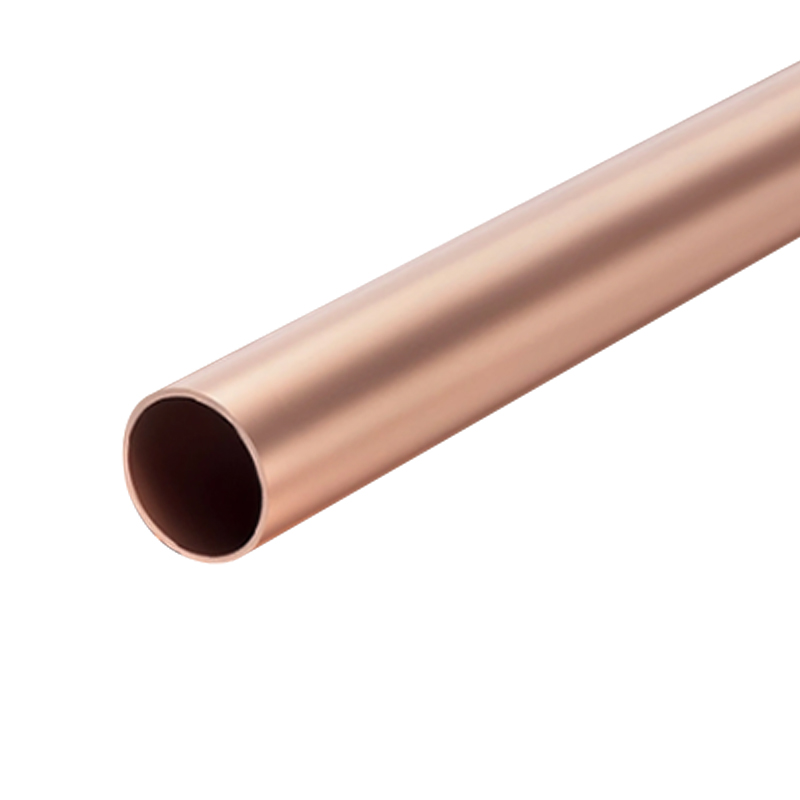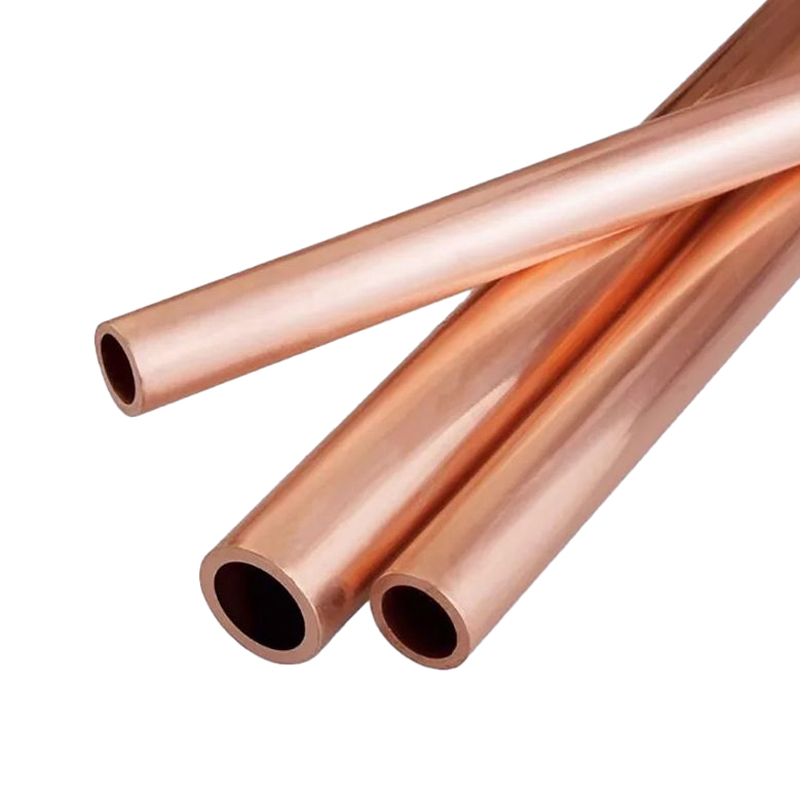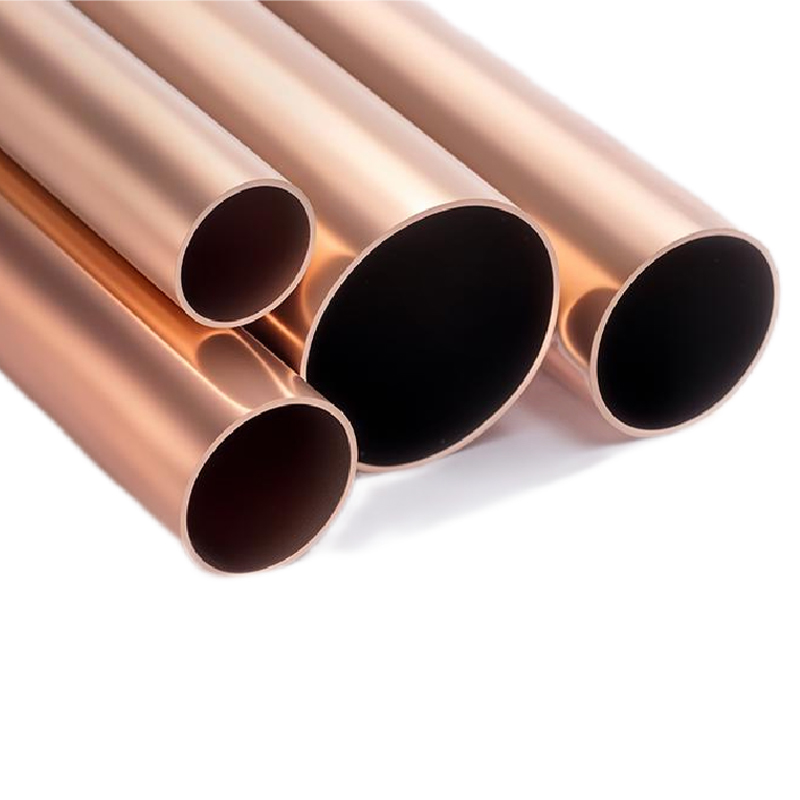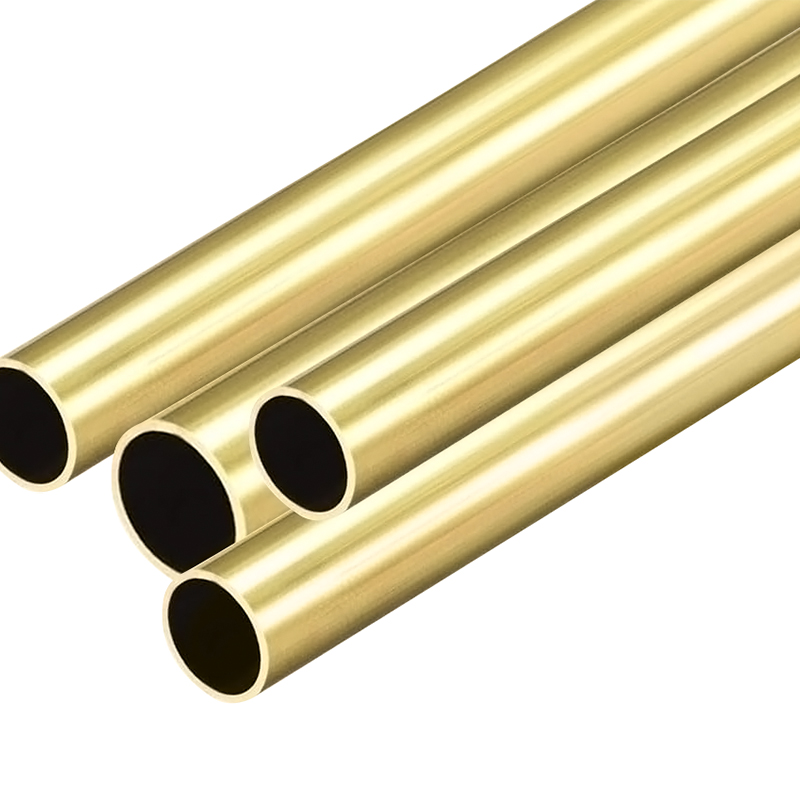The embossed copper tube is a high-performance heat exchange copper tube that is deeply processed and formed by a special mold on the basis of an ordinary smooth copper tube. It uses annealed copper tube as the base material, and is processed by a special embossing process to form a regular texture pattern on the outer surface of the copper tube. Through this design, the contact area between the copper tube and the air or refrigerant is significantly increased, which makes the heat conduction more sufficient and rapid, effectively improves the heat transfer coefficient, optimizes the heat transfer performance, and also improves the mechanical strength and vibration resistance of the tube body, which is suitable for various complex working conditions. This product is widely used in air conditioners, refrigerators, heat pumps, condensers, evaporators, and various industrial heat exchange equipment. It is an ideal choice for scenarios with high requirements for heat exchange efficiency. Especially in systems with limited space or high-performance heat dissipation requirements, embossed copper tube can achieve higher heat exchange efficiency with a smaller volume, helping equipment to save energy, reduce emissions, and operate stably.
ABOUT US
30+YEARS OF
EXPERIENCE
About Us
A Reliable Partner of the Copper Tube Industry
Zhejiang Jingliang Copper-Tube Products Co., Ltd established in 1994, is China Embossed Copper Tube Manufacturers and Custom Heat Exchange Copper Tube Suppliers, has been deeply involved in the copper tube industry for over three decades. The company primarily produce various specifications of products such as copper tubes, brass tubes, copper square tubes, fin copper tubes, copper capillary tubes, condenser copper tubes, copper evaporator tubes, and conductive rods, which are of quality and have earned the trust and acclaim of customers both domestically and internationally.
Wide Applications:
These products are widely used in various fields including air conditioning, refrigeration, heat exchange, sanitary ware, automotive, machinery, electric furnaces, and chemical industries.
Convenient Transportation:
Strategically located in Tangpu Town, renowned as the “home of copper tubes” in East China. Our company enjoys a prime location, adjacent to the Shangsan Expressway and National Highway 104, and is conveniently situated just over 70 kilometers from Hangzhou and Ningbo, ensuring easy accessibility and a business position.
Strong Financial Resources:
With its strong financial resources and advanced copper tube processing technology, our company holds an advantageous position in market share, brand value, technological content, and product quality, becoming a preferred supplier for many listed groups.
Large Scale Production:
The company occupies an area of over 20,000 square meters, with a construction area of 12,800 square meters. In 2022, our annual production exceeded 7,500 tons, with a value output of up to 450 million yuan, demonstrating our strong production capacity and market competitiveness.
Comprehensive Industry Chain:
Jingliang has now developed into a complete industrial chain integrating smelting, extrusion, drawing, precision rolling, and annealing. It has been awarded multiple honors, including "Top Ten Copper Tube Enterprises" and "Leading Taxpayer in the Copper Tube Industry".
Smart Manufacturing:
Jingliang Copper-Tube Products will better integrate the concept of factory construction into its corporate development strategy, insist on refining technology and polishing products more finely, and the future of "intelligent manufacturing".
Genuine Cooperation:
Zhejiang Jingliang Copper-Tube Products Co.,Ltd warmly welcomes friends from all walks of life to visit and offer guidance. We look forward to joining hands with you to create a brilliant future together.
Technical skills
Production Process
- 1、Electrolytic Copper
- 2、Copper Ingots
- 3、Press
- 4、Drawing
- 5、Rolling
- 6、Packaging
Electrolytic copper, produced through electrolytic processes, is a high-purity copper with good electrical conductivity and thermal conductivity, making it an ideal material for manufacturing copper pipes.
This marks the beginning of our production process, which involves the fabrication of electrolytic copper into pure copper or brass ingots according to specific requirements, followed by cutting to facilitate subsequent processing and handling.
In the pressing stage, the cut copper ingots are pressed into thin sheets or tubular shapes, forming the initial tube shape, and the copper ingots are prepared for drawing and rolling.
Drawing is the process of further processing the copper sheets or tubular objects that have been pressed into the required dimensions and shapes. Through drawing, our copper tubes can achieve precise outer diameters and wall thicknesses.
Rolling is the step of further processing the copper tubes after drawing. Through rolling, the copper tubes are rolled into more precise dimensions and shapes to meet the requirements of different applications.
Finally, the copper tubes that have undergone rolling will be packaged and prepared for shipping. We ensure that the packaging is safe and protective to prevent damage during transportation.
News
-
Copper Tube Industry Segmentation Report: How Are Niche Markets Reshaping the Competitive Landscape?
Subtitle: While traditional copper tubes grapple with price wars, segments like semiconductor-grade oxygen-free copper tubes and ultra-thin wall tubes for new energy vehicles achieve 30%+ gross margins—how do these niche products, represent...
READ MORE -
In the world of heat exchangers, air conditioning systems, refrigeration units, and other thermal management applications, the choice of materials for the tubes that facilitate heat transfer is crucial. Copper and aluminum are two of the mo...
READ MORE -
Refrigeration systems are essential in modern-day life, from preserving food and medicine to maintaining the comfort of our homes and workplaces. One of the key components that ensure the efficient operation of these systems is the capillar...
READ MORE
Industry knowledge
What are the advantages of using embossed copper tube in heat exchangers
Structure and technical features of embossed copper tubes
Embossed copper tubes are made by mechanically embossing the surface of the tube through a special mold on the basis of traditional smooth copper tubes to form regular protrusions or grooves. This structural design not only improves the surface area of the copper tube, but also significantly enhances its heat exchange capacity with fluid media (such as air, water, refrigerant, etc.). The surface texture can effectively break the boundary layer, so that the fluid will produce micro-turbulence when flowing inside or outside the tube, improve the heat transfer coefficient, and improve the energy efficiency of the overall system.
Advantages of using embossed copper tubes in heat exchangers
1. Improve heat transfer efficiency
The core of the heat exchanger is to achieve efficient heat transfer between media. Embossed copper tubes greatly increase the heat transfer rate by increasing the surface area and turbulence effect. According to industry data statistics, under the same conditions, the heat transfer efficiency of embossed copper tubes can be increased by 15% to 30% compared with light tubes, and their application in equipment such as air conditioners, refrigerators, condensers and evaporators is particularly significant.
2. Reduce the amount of refrigerant, green and environmentally friendly
Thanks to the high heat exchange capacity, embossed copper tubes can use smaller diameter or shorter length pipes while maintaining the same performance, which helps to reduce the overall volume of the system and reduce the refrigerant, in line with the development direction of green energy saving and environmental protection.
3. Enhance structural strength and pressure resistance
Because the surface embossing process changes the force distribution mode of the copper tube, the embossed copper tube is better than the ordinary light tube in pressure resistance. It is especially suitable for high-pressure and high-load operation scenarios, such as commercial air-conditioning systems or industrial heat pump equipment.
4. Extend service life
The embossed copper tube produces a disturbed flow on the fluid, which helps to reduce the adhesion of scale and dirt and reduce the risk of corrosion. In addition, Zhejiang Jingliang Copper-Tube Products Co., Ltd uses high-purity copper raw materials and precision extrusion technology to ensure that the product has excellent thermal conductivity and corrosion resistance, significantly improving the operating life and long-term stability of the system.
What are the welding performance and process precautions of embossed copper tube?
Analysis of welding characteristics of embossed copper tube
The main material of embossed copper tube is still high-purity copper, which has good thermal conductivity and ductility, so it has excellent weldability in theory. However, several characteristics brought by its surface embossed structure make the welding process more complicated:
Surface unevenness
Embossed causes continuous concave and convex textures on the surface of the copper tube, which will affect the spreading of the brazing material and the integrity of the weld, especially in automatic welding, it is easier to form weld nodules or cold welds.
Uneven local heat input
The metal thickness of the embossed area changes slightly, and the heat conduction rate is slightly different under high temperature, which may lead to uneven heating during welding. It is necessary to use zone heating or control the shape of the flame mouth.
Increased oxidation risk
The surface area of the copper material after embossing increases. If it is not controlled, it is easy to form an oxide layer before or during welding, affecting the strength and density of the welded joint.
Precautions for welding process
1. Pre-welding treatment is crucial
Before welding, the surface of the copper tube must be thoroughly degreased and deoxidized. Zhejiang Jingliang uses multiple cleaning and bright annealing processes to effectively ensure the clean surface of the copper tubes leaving the factory, providing a good foundation for customers' subsequent welding.
2. Choose the right solder
It is recommended to use low-temperature and high-wetness silver-based solder (such as BAg series) or phosphor copper solder (such as BCuP series), and decide whether to contain silver according to the stress of the welding part. For applications with high structural sealing requirements, such as condenser systems, silver-containing solder performs better.
3. Control heating method
Oxygen-acetylene flame is often used for manual welding. The flame should be adjusted to a neutral flame to prevent oxidation and keep the welding temperature within the range of 650℃ to 850℃; for mass production, automatic brazing equipment can be heated by infrared or electric induction, which is more conducive to the control of weld consistency.
4. Ensure fusion depth
If the embossed area is close to the weld, avoid contacting the solder only at the convex point. Zhejiang Jingliang recommends that customers use flared plug-in or sleeve welding when designing the connection structure to improve welding strength and anti-leakage performance.
5. Post-weld cleaning and testing
After welding, the weld should be cleaned and tested for air tightness. It is recommended to use nitrogen pressurization or water pressure testing process to ensure that the product meets the pressure resistance and sealing requirements.
How to detect the inner and outer surface quality defects of embossed copper tube
Common inner and outer surface defect types of embossed copper tube
Due to the influence of mechanical pressure and heat treatment during the forming process, embossed copper tube is more likely to produce the following typical surface defects:
Surface scratches and abrasions
Due to the contact between the pipe and the equipment parts during the transmission, rolling or handling process, it is very easy to leave obvious scratches on the raised lines.
Uneven embossing and deformation
If the embossing process is not properly controlled, some areas may be under- or over-deeply pressed, affecting the appearance and functionality.
Oxidation spots and surface stains
If the protective atmosphere is not strictly controlled during annealing or cooling, oxidation spots or spots are likely to appear on the surface of the copper tube.
Inner wall burrs or residues
Pulling chips, lubricants or oxide scales that have not been cleaned up may remain in the inner hole, affecting subsequent welding and fluid flow.
Pinholes, cracks and sand holes
Mostly originate from the quality of the ingot, extrusion stress or metal structure defects, which are extremely dangerous quality risks.
Detection methods and technical processes of embossed copper tubes
1. Manual visual inspection + strong light auxiliary inspection
This is the most basic and irreplaceable first line of quality defense. Zhejiang Jingliang has a special appearance inspection area. All embossed copper tubes must be inspected by professional quality inspectors in a 360-degree rotation under strong light to screen for obvious defects such as scratches, spots, and embossing deviations, and use high-definition magnifying glasses or digital images to strengthen the confirmation of doubts.
2. Laser profile scanning detection system
In order to realize the automated detection of embossing depth and shape consistency, Zhejiang Jingliang introduced a laser three-dimensional profiler, which can perform non-contact measurement on the surface of each section of the copper tube, and model and compare the geometric parameters of the embossing (such as peak distance, embossing depth, and repetition rate) in real time to ensure compliance with process standards.
3. Eddy Current Testing Technology
For fine cracks, pinholes and inclusions on the inner and outer surfaces of copper tubes, eddy current testing technology shows high sensitivity and efficiency. Eddy current testing can realize online fully automatic continuous testing, which is suitable for Zhejiang Jingliang's high-speed production line and has excellent recognition capabilities for microcracks, corrosion spots and welding defects.
4. Inner wall high-definition endoscope inspection
For embossed copper tubes with larger diameters, the inner wall defects are scanned using industrial video endoscopes, which can effectively detect invisible defects such as burrs, poor welds, and inner wall scratches. Zhejiang Jingliang is equipped with an original German imported high-definition probe system to ensure that there is no dead angle inspection inside the pipeline.
5. Color difference and surface uniformity analysis
The surface color of the copper tube is digitally monitored using a high-precision colorimeter to ensure that the product color is uniform after annealing. For export customer orders with high appearance requirements, the company customized an online spectral color difference comparison system to improve the product appearance grade.
6. Water pressure air tightness test and vacuum tightness test
For embossed copper tubes used in heat exchangers and condensers, water pressure and air tightness tests are required to detect whether there is microporous leakage. Zhejiang Jingliang has multiple special air tightness testing equipment, which can perform 100% testing on product batches to ensure that there is no leakage risk.

 English
English Español
Español
